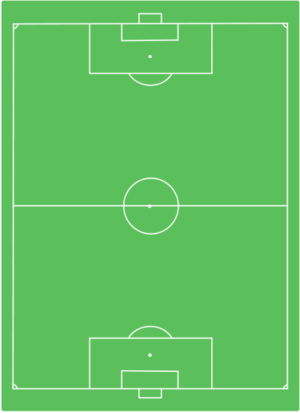Barcelona Sporting Club
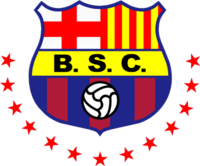 |
|||
| Full name | Barcelona Sporting Club | ||
|---|---|---|---|
| Nickname(s) | Idolo del Ecuador (Ecuadorian Idol) Ídolo del Astillero (Shipyard Idol) Toreros (Bullfighters) Equipo Canario (Canary Team) |
||
| Founded | May 1, 1925 | ||
| Ground | Estadio Monumental Banco Pichincha Guayaquil, Ecuador (Capacity: 89,930) |
||
| Chairman | |||
| Manager | |||
| League | Serie A | ||
| 2009 | 10th | ||
|
|||
Barcelona Sporting Club also known simply as Barcelona, is an Ecuadorian professional football club based in Guayaquil, Ecuador. They are tied with El Nacional as the most successful team in Ecuador with thirteen national championships. Barcelona is the first Ecuadorian team to make it to the Copa Libertadores finals, having done so twice in 1990 & 1998. Barcelona is ranked in the top 20 for the best club in South America for the 20th century by IFFHS[1]. Their main rival is crosstown team Emelec, with whom they play one of the most popular match in Ecuador, El Clásico del Astillero. Barcelona is team with the most amount of fans in Ecuador, which is why they are called El Idolo del Ecuador (The Idol of Ecuador). Barcelona is the only Ecuadorian team that has never been relegated to the Serie B.
Contents |
History
Foundation and early years (1925-1969)
|
Aguirre
Sangster
Guzmán
Murillo Moya
Franco
Márquez
Zevallos
Moría
Criollo
Pacheco
Viteri
|
| Barcelona Sporting Club's 1st squad of 15 June 1925. The coach was Eutimio Pérez. |
Barcelona Sporting Club was founded on May 1, 1925 by Eutimio Pérez, a Spanish immigrant who decided to name the club after his home city of Barcelona, Spain. The team was named after Pérez' return to Ecuador, BSC's Barça-like crest was adopted later on. The team competed in the provincial amateur tournament organized by Asociación de Fútbol del Guayas (AFG), which included clubs from around the Guayas Province in Ecuador. During the 1940s, Barcelona's popularity grew thanks in part to notoriety achieved by playing matches against important Colombian teams such as Deportivo Cali and Millionarios, two of the best teams from Colombia's golden era of football. Barcelona defeated Millionarios twice in Guayaquil, by scores of 3-2 and 1-0.
In 1950, Barcelona won their first AFG amateur title; the following year, the Association turned professional, and between 1951 and 1967, Barcelona racked up five professional regional titles and finished as runners-up six times, tying crosstown rival Club Sport Emelec for the most titles. In 1957, as one of the top two finishers in the Guayas regional tournament, Barcelona was invited to participate in the newly organized national football championship, which would crown a national championship from among the top two teams from both the AFG and the Interandino tournament disputed by teams from Quito and Ambato. Barcelona finished second in their first participation. Barcelona won its first national title in 1960, and became the first Ecuadorian team to compete in the South American continental tournament, the Copa Libertadores.
- First match: June 15, 1925 vs C.S. Ayacucho (1-0)
- First international match: March 19, 1931 vs
 Deportivo Cali (4-4)
Deportivo Cali (4-4)
Success, then fall from grace (1970s)
By the 1970s, Barcelona had established themselves as one of Ecuador's more popular teams after winning a number of provincial and national championships. Despite their national success, their performance in the Copa Libertadores had been lackluster, having exited the tournament early in competition. That changed in 1971, when they reached the semi-finals of the tournament with a star-studded squad that featured players such as Brazilian international Jose Paes, Peruvian World Cup player Pedro León, and Ecuadorian legend Alberto Spencer. Although they failed to reach the finals, at that time Estudiantes de La Plata was undefeated 4 years in row in home matches in Copa Libertadores, they managed to defeat three-time tournament winner Estudiantes de La Plata 1-0 in La Plata, later it would be recognized as La Hazaña de la Plata[2]. In 1972, they reached the semi-finals again, establishing themselves in the international stage.
The first two years of the decade were in stark contrast to the remainder; after the 1972 season, the club entered a dry spell that would last nine years. Barcelona did not win a national title, nor did it qualify for the Copa Libertadores, until the 1980s.
Resurgence (1980s)
In the 1980s, Barcelona shed the shackles of the prior decade and resurged on the international and domestic fronts. In 1980, the team won their first national title since 1971, going on to win four more before the end of the decade, making the 1980s the team's most successful period in terms of national titles; Barcelona became the first Ecuadorian squad to win 10 national championships. During this period, Barcelona competed in six editions of the Copa Libertadores, reaching the semi-finals twice in 1986 and 1987.
In 1987, Barcelona inaugurated a new home ground, the Estadio Monumental. With a capacity of almost 90,000 spectators, the Monumental is the largest stadium in Ecuador, and the second-largest in South America, after the Estádio do Maracanã in Rio de Janeiro.
The glory years (1990s)
The team’s most brilliant era came into place in the 1990s. In 1990, under a new president, and with the firm intention of conquering the Libertadores Cup, the club acquired key international players: former Argentine international and World Cup champion in 1986 Marcelo Trobbiani, Argentine international Alberto Acosta, and Uruguayan Marcelo Saralegui. With the inclusion of the foreign players and a batch of young as well as experienced Ecuadorian players, they played a fantastic tournament.
In 1990 Copa Libertadores edition, a dramatical semifinal home and away series, Barcelona beat River Plate of Argentina in a penalty shoot-out, to finally reach the long awaited final. Unfortunately they would come short, losing against Olimpia of (Paraguay) 2-0 in the away game, and tying 1-1 in the home game. Many considered the referee had affected the outcome in favor of the Paraguayan team. But with the runner up title, they would finally be considered among the best and most respected teams in South America.
In 1992, they put together another great team, beating the previous champions Colo-Colo (Chile) and reaching the Libertadores Cup Semifinals once again, but losing against the powerful Brazilian team of São Paulo FC, who at the time was coached by Tele Santana. Among their stars, São Paulo had players such as Zetti, Cafu, Rai, Müller and Palinha.
This decade also proved to show a negative side in the team’s history. On 25 December, three days after Barcelona had achieved the second place in the Ecuadorian league and earning a spot in the next Libertadores cup, Ecuadorian striker Carlos Muñoz died in a car accident at the age of 26.
After winning the Ecuadorian league title in 1997 (their last to date) with the help of such players as former Bolivian international Marco "El Diablo" Etcheverry, former Colombian international Anthony "El Pipa" De Avila and former Ecuadorian international Agustin "Tin" Delgado, they would go on to play the 1998 Libertadores Cup with mostly old players that seemed to be on their way out. But against all odds, they would reach their second Libertadores Cup final, losing both championship games against Brazilian team Vasco Da Gama, 2-0 in the away game and 2-1 in the home game.
While international titles eluded the team, the domestic front saw a number of successes; before the end of the decade, Barcelona took home three more national titles, bringing their overall count to 13, becoming the most successful team in the history of professional Ecuadorian football (Until 2006, when El Nacional reach them).
Title drought (2000s)
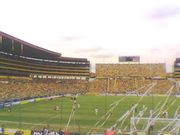
Barcelona has not won a national title since 1997, and participated in only two editions of the Copa Libertadores in the 2000s. Despite the lack of titles in recent years, the club remains among the most successful teams in the league, having managed three Serie A runners-up finishes in the decade. Barcelona continues to be among the top contributors to the Ecuadorian national team, and remains one of the most popular teams in Ecuador. The derby with crosstown team Club Sport Emelec, remains the most popular football game in Ecuador.[3]
In November 2007, Eduardo Maruri was elected President of Barcelona for 2007-2011 period. Maruri and Noboa (Barcelona's Vicepresident), brought the slogan La Renovacion (The Renovation) which promised to bring key international players also the best of Ecuadorian footballers and to clean up the mess that has kept Barcelona from winning a national title[4]. In 2009 season, was the worst season that Barcelona had in its history in the Serie A. Lots of teams like Deportivo Quito, Espoli, Deportivo Cuenca and LDU de Portoviejo came out and spoke about their concerned that if Barcelona was relegated, it would enormously impact in their economic situation, since when they play against Barcelona its almost a guarantee sold out in their home stadium because Barcelona has the largest supporters of any other team in Ecuador.[5] In October 03, 2009 more than 70,000 fans show up to Estadio Monumental Banco del Pichincha to support El Idolo del Ecuador from not being relegated to the Serie B. Barcelona beat LDU de Portoviejo 2-0, Goals from José Luis Perlaza (46), Juan Samudio. (90) in a intense match that save themselves from being relegated and to remain as the only Ecuadorian team that has never been relegated to the Serie B.[6][7][8]
New decade, New hope (2010-Present)
In the last decade, Barcelona participated in only two editions of the Copa Libertadores and three Serie A runners-up. On November 5, 2009, Barcelona's president Eduardo Maruri, announced the hiring of multimedia communications group from Spain, MediaPro to help them as a consultant and guide them on this new decade in the parts of advertisement, finance and sporting in hopes of bringing Barcelona back to the international level and to give the fans what they most desire, the 14th national title.[9][10]
Colours and badge
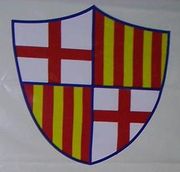
The crest of Barcelona has changed over the years. The teams' first crest consisted of a modified version of the city of Barcelona's Coat of Arms in dark blue borders. The team used this crest for two years until 1927. In 1935, the first major change came when they used Barcelona's flag in a circle, with a triangle behind it baring the team's initials. In 1955, after the team won their first Guayas Championship, the team adopted their current crest, which is similar to FC Barcelona's. Changes they made to it included the number of spikes, the color of the ball, border color, and the initials.
|
|
| Barcelona's original home kit in 1925. |
The team's traditional colors are yellow and black, with the home kit being all yellow since the mid 1950's. Prior to that, the teams used to play in black and white kits. For a period early in their history, the team used the a kit similar to FC Barcelona's, but after a series of losses in that uniform, the team president swore never to wear those colors again. In the 1940s, yellow was introduced, and would eventually become the team's primary color, replacing white altogether; black would become the secondary color, used in their alternate kit.
Stadium
Barcelona has played in three stadiums. Their first stadium was Estadio George Capwell, with whom they shared with crosstown rival Emelec as it was the only stadium in Guayaquill.
In 1959, they moved to the Guayaquil's brand new stadium Estadio Modelo. This was the stadium in which the teams played in during the golden years. For several years Barcelona shared this stadium with Emelec and Patria.
After Estadio Modelo's success, the president of Barcelona, Isidro Romero Carbo, initiated the project to give Barcelona their own stadium. Romero talked with Jaime Nebot, Guayaquil's mayor, and León Febres Cordero, then President of Ecuador (both of whom are Barcelona fans) about the idea; they decided to help. Nebot donated a huge ground, the San Eduardo garbage dump site, for construction and Febres Cordero helped him with money. In 1986, Romero put up the first block of the stadium in 1986. In 1987, Estadio Monumental opened for the first time. The stadium was the first in Ecuador to have suites, and became the largest in terms of capacity, with space for close to 90,000 fans.
Recently the team signed a ten year deal with Latin America Futbol Corporation to install a state of the art LED perimeter board in the Estadio Monumental Banco Pichincha. The 243 meter LED perimeter board was installed in September, 2008 and is the first LED perimeter board in an Ecuadorian football stadium. The deal is a 50-50 partnership between the two groups.
El Clásico del Astillero
El Clásico del Astillero is a match played against Barcelona's old rival Emelec. It was not until 22 August 1943 that the two sides faced each other for the first time, in a Guayaquil League match. Sporting their distinctive yellow jerseys, Los Canarios defeated El Eléctrico 4-3, with Pedro Villalta scoring a late winner for Barcelona. It was a match that would forever be remembered as The Derby of the Posts due to the number of times that the Emelec forwards struck the woodwork.
In 1948, the local derby received a name of its own in a preview in the newspaper El Universo, becoming known forever more as El Clásico del Astillero (The Shipyard Derby).
In 1990, proved to be a very special year in the history of El Clásico del Astillero, with the two sides facing off in a Copa Libertadores quarter-final second leg on 29 August. Barcelona advanced to the semis after a 1-0 win.
The rivalries between these two teams was immense in Ecuador and international that it caught the eye of international filmmaker Filmadora Panamericana and in 1973 a movie was made titled "El derecho de los pobres", starting Spanish actor Enrique Rambal, Mexican actor Enrique Rocha and Ecuadorian footballer Alberto Spencer, proclaim the best Ecuadorian soccer player of all times, makes his cinema debut[11].
Although Barcelona have failed to win the title since 1997 and Emelec since 2002, it still remains as one of the most important match in Ecuador and is recognized by FIFA as one of the fiercest football rivalries in the world.[12][13]
Supporters
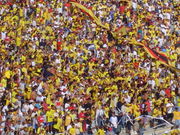
Barcelona has the largest fanbase of any team in Ecuador[14] and is the only team in Ecuador that has fans from every city in the country.
When Barcelona plays against other rivalry's in other cities apart from his home stadium in Guayaquil, it seems like Barcelona is the host because of so many followers that show up to the stadium to root for Barcelona.
Barcelona's ultras are known as La Sur Oscura (English: The Dark south). During home matches, they are located in the southern end of the Estadio Monumental. In Quito Barcelona's Ultras are known as Sur Oscura Quito (English: Dark Highland Quito).
Another Barcelona's Ultra are known as Zona Norte (English: North Zone) and many more from different parts of the country.
List of Chairmen
Eduardo Maruri is the current chairman of the Barcelona. He was elected for the 2007-2011 period[15][16]
| Name | Years | Notes | |
|---|---|---|---|
| 1 | Carlos García Ríos | 1925-1927 | |
| 2 | José Salem Dibo | 1927-1928 | |
| 3 | Manuel Díaz-Granados | 1928-1929 | |
| 4 | Dantón Suárez | 1929-1931 | |
| 5 | Ovidio Ramírez Chacón | 1931 | |
| 6 | Fernando Vicenzini | 1931-1932 | |
| 7 | Victoriano Arteaga Martinetti | 1932-1943 | |
| 8 | Wilfredo Rumbea León | 1943-1946 1952-1953 | |
| 9 | Federico Muñoz Medina | 1946-1951 | |
| 10 | Luis Guerrero | 1954 | |
| 11 | Miguel Salem Dibo | 1955-1957 | |
| 12 | Eduardo Servigón | 1957-1958 | |
| 13 | Luis Falquez | 1958 | |
| 14 | Ernesto Mosquera | 1958-1960 | |
| 15 | José Bruno Cavanna | 1960 | |
| 16 | Ernesto Ycaza Morla | 1961 | |
| 17 | Emilio Baquerizo Valenzuela | 1962-1964 | |
| 18 | Alfonso Trujillo Bustamante | 1965 | |
| 19 | Rigoberto Aguirre Coello | 1966 | |
| 20 | Galo Roggiero Rolando | 1967-1970 1986 2006-2007 | |
| 21 | Aquiles Alvarez Lértola | 1971 | |
| 22 | Carlos Coello Martínez | 1972-1973 | |
| 23 | Luis Martin Rubio | 1973 | |
| 24 | Ottón Morán | 1973 | |
| 25 | Mario Moncayo Merino | 1973 | |
| 26 | Silvio Devotto Passano | 1974 | |
| 27 | Francisco Mena | 1975 | |
| 28 | Nicolás Romero Sangster | 1975 | |
| 29 | Miguel Marchán | 1976-1977 | |
| 30 | José Tamariz | 1978-1982 | |
| 31 | Isidro Romero Carbo | 1982-1986 1990-1997 2005-2006 | |
| 32 | Heinz Moeller Freire | 1986-1988 | |
| 33 | Jorge Guzmán Ortega | 1988 | |
| 34 | Octavio Hernández Valarezo | 1989 | |
| 35 | Abdalá Bucaram | 1997 | |
| 36 | Xavier Paulson | 1997-1998 | |
| 37 | Jorge Bejarano Orrantia | 1999 | |
| 38 | Miguel Palacios Frugonne | 2000-2001 | |
| 39 | Leonardo Bohrer Pons | 2002-2005 | |
| 40 | Eduardo Maruri | 2007- |
Current squad
Current squad for Barcelona Sporting Club as of October 1, 2010 ()
Sources: BDFA squad list
|
|
Manager: Rubén Darío Insúa
|
Banguera
De Jesus
Hurtado
Perlaza
Nazareno
Oyola
Hidalgo(C)
Quiñonez
Noir
Bolaños
'Samudio
|
| 2010 Season Formation 4-3-3 and Lineup[17] |
Players in for 2010
Note: Flags indicate national team as has been defined under FIFA eligibility rules. Players may hold more than one non-FIFA nationality.
|
Players out for 2010
Note: Flags indicate national team as has been defined under FIFA eligibility rules. Players may hold more than one non-FIFA nationality.
|
Noted players
Sorted by nationality (nickname in parenthesis).
|
|
|
Noted Squads
Copa Libertadores Finals Squad 1990 Note: Flags indicate national team as has been defined under FIFA eligibility rules. Players may hold more than one non-FIFA nationality.
|
|
Copa Libertadores Finals Squad 1998 Note: Flags indicate national team as has been defined under FIFA eligibility rules. Players may hold more than one non-FIFA nationality.
|
|
Noted managers
List is sorted by nationality.
|
|
|
Achievements[18]
National
- Campeonato Ecuatoriano de Fútbol Primera A
- Champion (13): 1960, 1963, 1966, 1970, 1971, 1980, 1981, 1985, 1987, 1989, 1991, 1995, 1997
- Runner-up (11): 1957, 1962, 1968, 1982, 1986, 1990, 1992, 1993, 2002, 2003, 2005-A
- Campeonato Professional de Guayaquil
- Champion (5): 1955, 1961, 1963, 1965, 1967
- Runner-up (6): 1953, 1954, 1957, 1962, 1964, 1966
- Campeonato Amateur del Guayas
- Champion (1): 1950
- Copa AsoGuayas
- Reserves Cup (1): 2006
International
- Copa Libertadores
- Runner-up (2): 1990, 1998
International Friendly
- Copa Antonio Labán Delgado de Chile
- Champion (1): 1993
Records
In Serie A:
- Seasons: 49
- All-time position: 1st
- Best finish: 1st (13 times)
- Worst finish: 9th (2009)
- Biggest win: 7-0 vs. Técnico U.
- Biggest defeat: 7-0 vs. El Nacional
- Most caps: Nicolás Asencio
- Top scorer: Manuel Uquillas (86 goals)
- Less goals conceded: Pablo Ariel Santillo (796 minutes)
See also
- Estadio Monumental Banco del Pichincha
- Serie A de Ecuador
References
- ↑ http://www.iffhs.de/?32b0cfd380ff73117fe2c0bf23c17e23a09e33b17f7370eff3702bb1c2bbb6e20e52c00f23808f15
- ↑ "La Hazaña de la Plata". BSC Official Web site. 2010-03-06. http://www.barcelonasportingclub.ec/hazana_plata.php. Retrieved 2010-03-06.
- ↑ "El Clásico del Astillero". Football Derbies. 2010-02-11. http://www.footballderbies.com/honours/index.php?id=119. Retrieved 2010-02-11.
- ↑ "Maruri ganó las elecciones". EL UNIVERSO. 2007-11-23. http://www.eluniverso.com/2007/11/23/0001/15/6620B50A617D4C398116F07499B8D9B6.html. Retrieved 2010-03-06.
- ↑ "Y si Barcelona desciende a la B?". UltimasNoticias. 2009-09-18. http://www.ultimasnoticias.ec/noticiaUN.asp?id_noticia=32025&id_seccion=8. Retrieved 2009-09-18.
- ↑ "Barcelona salvó la categoría". EL UNIVERSO. 2009-10-03. http://www.eluniverso.com/2009/10/03/1/1372/barcelona-salvo-categoria.html. Retrieved 2009-10-03.
- ↑ "Barcelona de Guayaquil Salva la Categoría de Fútbol Video". LATV Ecuador. 2009-10-04. http://www.tvecuador.com/index.php?option=com_reportajes&view=showcanal&id=1171&Itemid=27. Retrieved 2009-10-04.
- ↑ "EL ÍDOLO DEL ECUADOR GANÓ 2X0". BSC official website. 2009-10-03. http://www.barcelonasportingclub.ec/noticias.php?id=234. Retrieved 2009-10-03.
- ↑ "Maruri “Este grupo asesor nos va a guiar hacia la nueva década”". BSC official website. 2009-11-05. http://www.barcelonasportingclub.ec/noticias.php?id=272. Retrieved 2009-11-05.
- ↑ "Barcelona llegó a un acuerdo con Mediapro”". BSC official website. 2009-11-05. http://www.barcelonasportingclub.ec/noticias.php?id=271. Retrieved 2009-11-05.
- ↑ http://www.imdb.com/title/tt0310999/
- ↑ "El Clásico del Astillero". FIFA. 2010-01-29. http://www.fifa.com/classicfootball/stories/classicderby/news/newsid=1032716.html#ecuadors+shipyard+derby. Retrieved 2010-01-29.
- ↑ "FIFA List of Recognized Derbys of the World". FIFA. 2010-01-29. http://www.fifa.com/classicfootball/stories/classicderby/archive/index.html. Retrieved 2010-01-29.
- ↑ http://www.futbolecuador.com/stories/publica/13245
- ↑ "Barcelona's Directory". Barcelona SC. 2010-02-21. http://www.barcelonasportingclub.ec/directorio.php. Retrieved 2010-02-21.
- ↑ "Barcelona's History". Barcelona SC. 2010-02-21. http://www.barcelonasportingclub.ec/historia.php. Retrieved 2010-02-21.
- ↑ "Barcelona's Squad". EL UNIVERSO. 2010-02-21. http://www.el-universo.net/especiales/campeonato2010/barcelona.html. Retrieved 2010-02-21.
- ↑ http://www.barcelonasc.ec/club_palmares.asp
External links
- Barcelona SC, Club official website
- Hinchaamarillo, The Official fan base website
- Barcelona SC Video, Youtube Video
- Barcelona SC, Club largest fan base outside of Ecuador
- RAZA AMARILLA, Barcelona Sporting Club News
|
||||||||||||||
